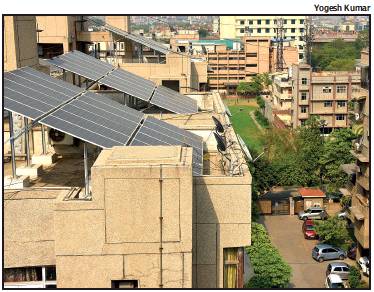Delhi: IP Extension
This is a collection of articles archived for the excellence of their content. |
Milan Vihar
2018/ 140 kWp solar PV plant
This east Delhi colony is now powered by Sun, May 14, 2018: The Times of India

From: This east Delhi colony is now powered by Sun, May 14, 2018: The Times of India
After Dwarka, a cooperative housing society in east Delhi has now gone solar.
Chief minister Arvind Kejriwal inaugurated a 140 kWp solar PV plant at Milan Vihar cooperative society in IP Extension on Sunday. According to officials, the plant will generate 1.7 lakh units in a year and the society will earn Rs 3.4 lakh per year as generation-based incentive. Sources said many other housing societies are likely to switch to solar power in the coming weeks.
The recent surge in solar rooftop plants is a result of the government’s efforts to make Delhi a ‘solar city’. The power department’s Energy Efficiency and Renewable Energy Management Centre had empanelled vendors for installation of rooftop solar PV plants on buildings at competitive rates. “Through this, group housing societies having a large potential for solar energy can benefit through Central Finance Scheme and generation-based incentive,’’ said an official.
With 1,365 rooftop solar systems having an installed capacity of 90 MWp, Delhi has the most number of such systems in comparison to other states. “Of this, 5 MWp capacity systems have been installed in the domestic sector. It is because of mass-scale adoption of solar energy in Delhi,’’ said an official. To promote this objective, the government came out with a solar policy for Delhi, under which the target is to achieve installation of 1,000 MWp by 2020 (14% of peak load, 4% of total energy demand) and 2,000 MWp by 2025 (21% of peak load, 7% of total energy demand). The policy also stressed on mandatory installation of solar panels on government institutions that have a rooftop area of 500 sqm or above.
Earlier this month, Shiv Bhole Cooperative Group Housing Society in Dwarka became the first cooperative group housing society to go live as part of BSES Rajdhani Power Limited’s (BRPL) solar city initiative.
Discoms said a 1kW solar photovoltaic (PV) rooftop system is expected to generate 4-5 kilowatt hours (kWh) of electricity per day, resulting in an average monthly saving of about Rs 750 for a period of 25 years for single-point delivery consumers. “To set up the solar plant, a 30% capital subsidy is provided by the ministry of new and renewable energy, along with Rs 2 per unit generation-based incentive,” said a discom official.